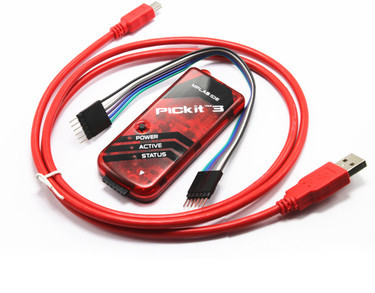Introduction of PICkit 3
Microchip’s PICkit 3 In-Circuit Debugger/Programmer uses in-circuit debugging logic incorporated into each chip with Flash memory to provide a low-cost hardware debugger and programmer. In-circuit debugging offers these benefits:
Low cost
Minimum of additional hardware needed for debug
Expensive sockets or adapters are not required
The PICkit 3 can now also reprogram any PIC microcontroller with a simple push of a button: Find out more about Programmer-To-Go function*
*Please consult the PICkit 3 readme to determine Programmer To Go device support limitations.
Note: The PICkit 3 In-Circuit Debugger/Programmer is NOT a production programmer. It should be used for development purposes only.
The MPLAB PICkit 3 allows debugging and programming of PIC? and dsPIC? Flash microcontrollers at a most affordable price point using the powerful graphical user interface of the MPLAB X Integrated Development Environment (IDE). The MPLAB PICkit 3 is connected to the design engineer’s PC using a full speed USB interface and can be connected to the target via an Microchip debug (RJ-11) connector (compatible with MPLAB ICD 2, MPLAB ICD 3 and MPLAB REAL ICE). The connector uses two device I/O pins and the reset line to implement in-circuit debugging and In-Circuit Serial Programming?.
If you need older software for programming with your PICkit 3, please visit our archives.
The MPLAB PICkit 3 supports our entire portfolio of PIC and dsPIC products. Because product support of MPLAB PICkit 4, MPLAB Snap and MPLAB ICD 4 is not complete yet, MPLAB PICkit 3 may be the primary tool to support your MCU. Please consult the product support matrix available in the MPLAB X IDE help file for debugger support information.
Header Information
Some 8-, 14- and 18-pin devices use small header boards with a special MCU for debugging. This special MCU has extra pins for PICkit 3 communication and therefore allows the use of all pins on the part for the application. The header board is not used or needed for programming. However, when debugging these devices the header must be used.
